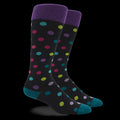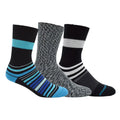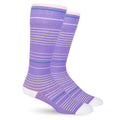What Are The Differences In Compression Socks vs Regular Socks?
Posted by SIMON LIM

Maybe you've been debating whether or not compression socks are necessary or if regular socks will be enough? To answer your questions here’s a short discussion of the difference between compression socks vs regular socks, so read on.
The benefits of compression socks over conventional socks are innumerable: they keep muscles warm before activities, improve blood flow during and after exercises, and even help avoid injuries. Regular socks may keep you warm, but they don't provide the support compression socks give!
What’s The Deal With Regular Socks?

Regular socks have the primary purpose of absorbing sweat. Our feet create more than 0.25 US quarts (0.12 l) of perspiration per day, and socks can help collect this sweat and direct it to regions where the air can evaporate. Socks made of cotton or wool in chilly conditions assist warm cold feet, reducing the danger of frostbite. While in the summertime, it's best to wear thin socks to keep your feet cool.
Regular socks are usually made from different fabrics such as cotton, wool, silk, linen, and mohair, to name a few. These fabrics are used with the goal in mind of providing an increased level of softness rather than medical reasons.
How Are Compression Socks Different?

When you’re looking at compression socks vs regular socks, the best compression socks provide a great way to relieve swelling and pain in the calves and legs and prevent further injury. These socks are an excellent choice for anyone who spends a lot of time on their feet or has had previous lower limb medical injuries. Regular socks don't provide the same comfort and protection as these socks.
Lightweight fabrics like nylon, lycra, or spandex, which are stretchable, are commonly used in manufacturing compression socks. The material is breathable, so sweat and moisture will be wicked away from the body while keeping the muscles warm and supple.
Compression levels between 15 and 30 mmHg are often advised for optimal results (this measurement is millimeters of mercury). In addition to the circumference (which should be measured at the widest region of the calf) and leg length, compression socks come in various sizes. Getting the most out of the compression socks requires a proper fit.
If you're looking for graduated compression, Dr. Segal's has two options: Mild compression with 15-20 mmHg pressure and moderate compression with a pressure of 20-30 mmHg.
The 15-20 mmHg compression socks are ideal for travelers, pregnant women, and anyone who spends long periods sitting or standing. People with tired, achy legs or slight swelling can get relief quickly with the help of these mild compression socks.
But for people experiencing moderate swelling, chronic venous insufficiency, sclerotherapy post-treatment, or the management of healed venous ulcers all call for the 20-30 mmHg compression socks.
Key Takeaways

For the muscles to receive the proper amount of oxygen and nutrients during physical activity, compression socks for men and compression socks for women help to enhance blood flow. Designed with graduated compression, compression socks have a tighter foot and a looser thigh. This is one of the primary differences between compression socks vs regular socks.
It helps the blood flow up the leg (known as venous return) and via the veins valve system, preventing pooling and increasing the overall efficiency of blood flow.
The best compression socks, like regular socks, are available in a wide range of colors to go with your other sports gear or uniforms and are as pleasant as they are protective of your lower limbs.
Dr. Segal's Compression Socks have unique design and technological characteristics to maximize support, comfort, and performance.
SHARE:





































